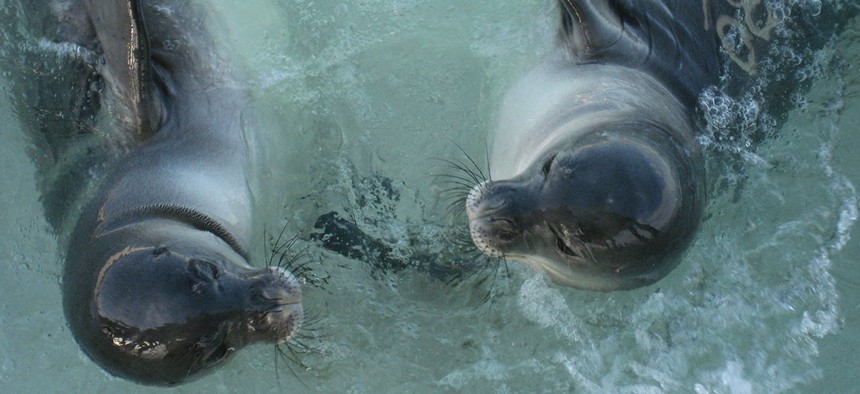
Two Hawaiian seal pups play at Papahānaumokuākea Marine National Monument. NOAA file photo
The World's Biggest Marine Refuge: 442,000 Square Miles, 7,000 Species, 5 Sunken Aircraft Carriers
President Obama quadrupled the Papahānaumokuākea Marine National Monument on Friday, protecting a wide swath of ocean near Hawaii.
With a stroke of a pen Friday, the Papahānaumokuākea Marine National Monument became as large as its name.
President Obama added more than 442,000 square miles to the Pacific Ocean wildlife refuge north of Hawaii on Friday, quadrupling its size and cementing its status as the largest marine protected area on Earth.
Living within the protected area are more than 7,000 marine species, including 24 species of whales and dolphins and five protected species of sea turtles, as well as foraging areas for the endangered Hawaiian monk seal and remote nesting atolls for numerous species of seabirds.
Papahānaumokuākea also holds cultural and historical significance for Pacific communities. The White House cited the vast seascape’s important spiritual role for native Hawaiians in Friday’s announcement:
The ocean will always be seen as an integral part of cultural identity for the Native Hawaiian community. The deep sea, the ocean surface, the sky, and all the living things in the area adjacent to the Monument are important to this culture and are deeply rooted in creation and settlement stories. Native Hawaiian culture considers the Monument and the adjacent area a sacred place. This place contains the boundary between Ao, the world of light and the living, and Pō, the world of the gods and spirits from which all life is born and to which ancestors return after death. Long-distance voyaging and wayfinding is one of the most unique and valuable traditional practices that the Native Hawaiian community has developed and continues to advance.
Once on the verge of cultural extinction, new double-hulled sailing canoes, beginning with the Hōkūle'a in the 1970s, are bringing voyaging and wayfinding to new generations. This traditional practice relies on celestial, biological, and natural signs, such as winds, waves, currents and the presence of birds and marine life. The open ocean ecosystem and its natural resources in the adjacent area play an important role within the cultural voyaging seascape within the Hawaiian Archipelago.
“This is one of the most important actions an American president has ever taken for the health of the oceans,” Senator Brian Schatz of Hawaii, who formally proposed the expansion last year, said in a statement. “Expanding Papahānaumokuākea will replenish stocks of ‘ahi, promote biodiversity, fight climate change, and give a greater voice to Native Hawaiians in managing this resource. President Obama’s declaration is only the beginning.”
Also located within the site is the wreckage of five aircraft carriers sunk at the Battle of Midway in 1942, perhaps the most pivotal battle of World War II’s Pacific theater. Four of the carriers—the Akagi, Kaga, Soryu, and Hiryu—were part of the Japanese fleet that attacked Pearl Harbor, while the fifth—the USS Yorktown—was part of the U.S. naval force that ambushed them six months later. Japan’s navy never recovered from the losses.
Obama expanded Papahānaumokuākea through authority granted to him by the Antiquities Act of 1906, a statute that allows presidents to create national monuments out of public lands. National monuments are distinct from national parks, which are created by acts of Congress.
NEXT STORY: Screening for Zika in Donated Blood







